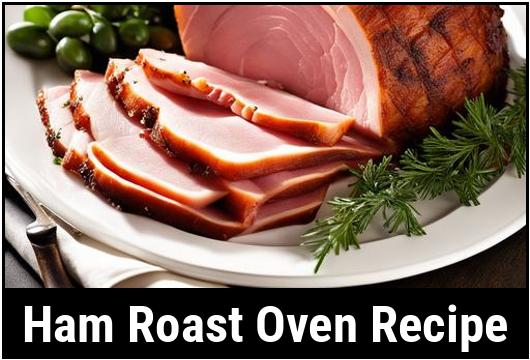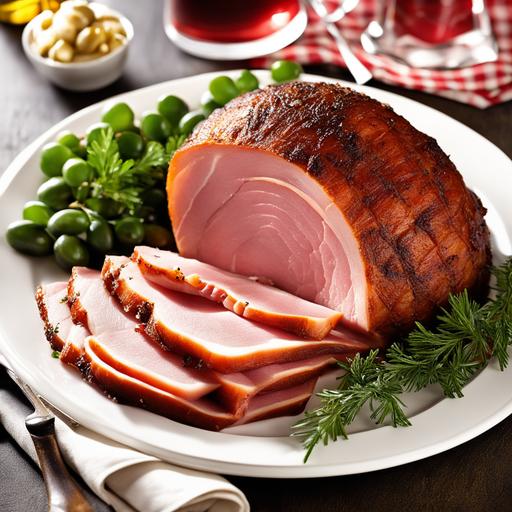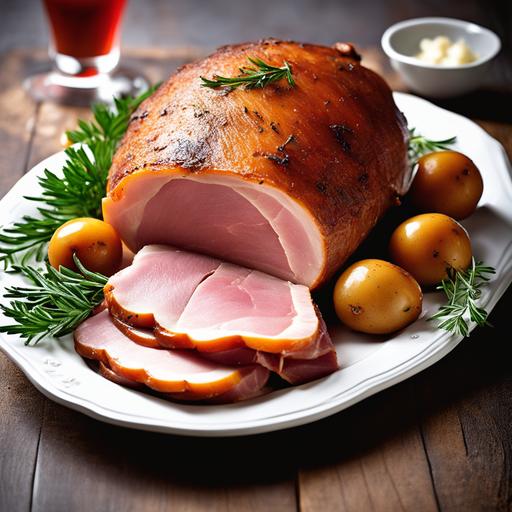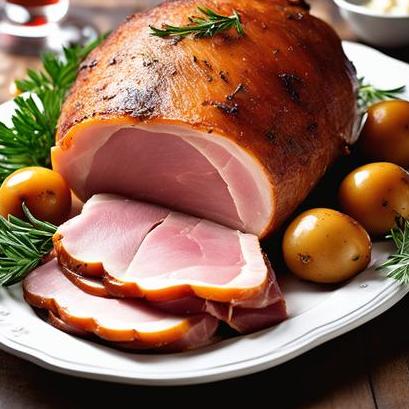
Ham Roast Oven Recipe: A Comprehensive Guide
Bringing the perfect blend of flavors and a delightful entree to your dining table
Ham roast is a classic and crowd-pleasing dish that never fails to impress. With its succulent texture, savory aroma, and mouthwatering taste, it is the ultimate centerpiece for any occasion. In this comprehensive article, we will explore the art of preparing a ham roast in the oven, covering various aspects such as food science, culinary details, selection, cleaning, preparation, tips, variations, doneness checks, and more. So roll up your sleeves, grab your apron, and let’s delve into the world of ham roast perfection!
Why Choose Ham Roast?
Ham roast is a versatile dish that offers an array of benefits. Not only is it a common choice for celebratory feasts, but it also serves as a delightful family meal. The ham’s unique combination of flavors, ranging from smoky to sweet, complements a variety of side dishes and adds a touch of elegance to your dining experience. Additionally, ham roast is an excellent source of protein, essential vitamins, and minerals that contribute to a balanced diet.
Understanding the Food Science Behind the Perfect Ham Roast
To achieve the ideal ham roast, it is crucial to understand the science behind it. Ham is typically obtained from the hind leg of a pig and then cured or smoked to enhance its flavor. During the cooking process, the heat causes the proteins in the ham to denature and bond, resulting in increased tenderness and succulence. Furthermore, the natural fats within the ham assist in providing moisture and flavor, creating a juicy and delightful final product.
Selecting the Perfect Ham for Roasting

When it comes to selecting a ham for roasting, you have several options to consider. The two most common types of ham you’ll encounter are boneless and bone-in hams. Boneless hams tend to be easier to carve, while bone-in hams offer enhanced flavor due to the presence of the bone. Choose a ham that weighs approximately 10-12 pounds to ensure there is enough meat to feed a gathering of people or to provide leftovers for future meals.
Preparing and Cleaning the Ham

Before preparing the ham for roasting, it is important to clean it thoroughly. Gently rinse the ham under cold running water to remove any remnants of curing solution or excess surface salt. Pat the ham dry with a clean towel. Once cleaned, place the ham on a clean cutting board and trim off any excess fat, leaving a thin layer to enhance flavor and moistness during cooking. Remember to remove the rind if it hasn’t been removed already.
Tips for Preparing the Perfect Ham Roast

To achieve the perfect ham roast, there are a few essential tips to keep in mind:
-
Allow the ham to reach room temperature: Before placing the ham in the oven, allow it to sit at room temperature for 30 minutes to an hour. This ensures even cooking throughout the meat.
-
Score the ham: Create shallow cuts on the surface of the ham in a diamond pattern. This helps the flavors penetrate the meat and adds an attractive presentation aspect to the final dish.
-
Glaze and baste: Applying a tasty glaze and basting the ham during the cooking process adds depth of flavor and promotes caramelization. Traditional glazes can be made with ingredients such as honey, brown sugar, mustard, or maple syrup.
-
Use a meat thermometer: To ensure the perfect level of doneness, invest in a meat thermometer. This handy tool allows you to monitor the internal temperature of the ham, ensuring it reaches the desired level of doneness without drying out.
Understanding Doneness and Avoiding Overcooking or Undercooking

Cooking the ham to the appropriate level of doneness is vital for both taste and food safety. Overcooking can result in a dry and unappealing piece of meat, while undercooking poses health risks. The USDA recommends cooking ham to an internal temperature of 145°F (63°C) to ensure it is safe to eat. However, certain recipes may call for slightly different temperatures, resulting in variations of desired textures.
When using a meat thermometer, ensure it is inserted into the thickest part of the ham without touching the bone. Once the ham reaches the desired temperature, remove it from the oven and allow it to rest for at least 15 minutes before carving. During this resting period, the internal temperature of the ham will continue to rise by a few degrees, resulting in a moist and flavorful centerpiece for your table.
Recipe: The Ultimate Ham Roast
Now that we have explored the science, selection, and preparation tips, it’s time to dive into a mouthwatering ham roast recipe that will impress your guests and leave them asking for seconds.
Ingredients:
-
1 bone-in ham (10-12 pounds)
-
1 cup brown sugar
-
1/2 cup honey
-
2 tablespoons Dijon mustard
-
1 teaspoon ground cloves
Instructions:
-
Preheat the oven to 325°F (163°C).
-
Place the ham on a rack in a roasting pan, ensuring the fat side is facing up.
-
Score the surface of the ham in a diamond pattern, approximately 1/4 inch deep.
-
In a small saucepan, combine the brown sugar, honey, Dijon mustard, and ground cloves. Heat over low heat, stirring until the sugar has dissolved and the glaze has formed.
-
Brush a generous amount of glaze over the ham, ensuring it seeps into the scored cuts.
-
Insert a meat thermometer into the thickest part of the ham, avoiding contact with the bone.
-
Place the ham in the preheated oven and roast for approximately 15-18 minutes per pound, or until the internal temperature reaches 145°F (63°C).
-
Every 30 minutes, baste the ham with the remaining glaze to enhance the flavors and create a deliciously caramelized exterior.
-
Once the ham reaches the desired temperature, remove it from the oven and let it rest for at least 15 minutes.
-
Carve the ham, following the scored lines, and serve it warm as the centerpiece of your exquisite meal.
Variations and Serving Suggestions
While our recipe provides a classic and delicious ham roast, there are several variations you can explore to cater to different tastes and preferences:
-
Herb-Infused Ham: Season the ham with a combination of fresh herbs, such as rosemary, thyme, and sage. This adds a fragrant and earthy element to the dish.
-
Pineapple-Glazed Ham: Replace the honey in the glaze recipe with pineapple juice for a tropical twist. The slight tanginess of the pineapple beautifully complements the savory flavors of the ham.
-
Mustard and Brown Sugar Glaze: Combine yellow mustard, brown sugar, and a hint of apple cider vinegar for a tangy-sweet glaze that cuts through the richness of the ham.
When serving your delectable ham roast, consider pairing it with a variety of classic sides such as creamy mashed potatoes, roasted vegetables, and a fresh garden salad. Don’t forget to offer your guests an assortment of mustards and chutneys as condiments to enhance their dining experience.
In conclusion, the art of preparing a ham roast in the oven is a journey filled with savory aromas, doneness checks, and delectable flavors. From understanding the science behind cooking to selecting the perfect ham, and ensuring the appropriate level of doneness, each step contributes to an exquisite final dish. So gather your ingredients, embrace your inner chef, and embark on the wonderful adventure of creating a memorable ham roast for your loved ones.
Sources
FAQS On Ham Roast Oven Recipe
What Is The Best Way To Prepare A Ham Roast In The Oven?
The best way to prepare a ham roast in the oven is to preheat your oven to 325°F. Place the ham roast in a roasting pan and add 1/2 cup of water to the bottom of the pan to keep the meat moist. Then cover the ham roast with aluminum foil and roast for 15-20 minutes per pound, or until the internal temperature reaches 140°F.
What Seasonings Work Well With Ham Roast In The Oven?
Seasonings that work well with ham roast in the oven include brown sugar, honey, mustard, garlic, cloves, and herbs like thyme, rosemary, and sage. You can create a glaze by mixing these seasonings with some fruit juice or soda to brush over the ham roast during the cooking process.
How Long Should A Ham Roast Cook In The Oven?
A ham roast should cook in the oven for approximately 15-20 minutes per pound, or until the internal temperature reaches 140°F. It’s important to use a meat thermometer to ensure the ham roast is cooked to the proper temperature to ensure it is safe to eat.
Should The Ham Roast Be Covered With Foil While Cooking In The Oven?
Yes, it’s recommended to cover the ham roast with aluminum foil while cooking in the oven. This will help to keep the meat moist and prevent it from drying out during the cooking process.
How Can I Ensure My Ham Roast Is Juicy And Flavorful When Cooked In The Oven?
To ensure your ham roast is juicy and flavorful when cooked in the oven, be sure to baste it with the pan juices every 30 minutes. You can also add additional seasonings or a glaze during the cooking process to enhance the flavor. Additionally, be sure to let the ham roast rest for 10-15 minutes before slicing to allow the juices to redistribute throughout the meat.


